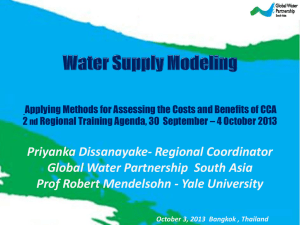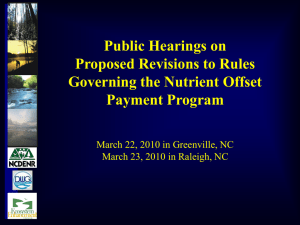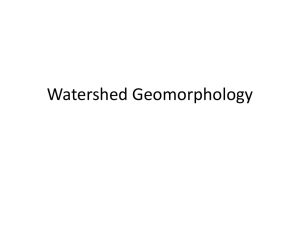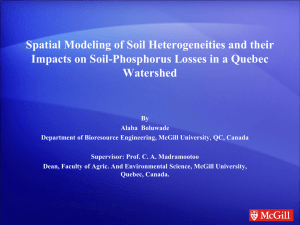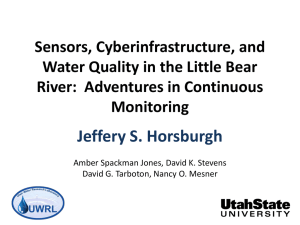Hydrologic Fluxes and Flows
advertisement
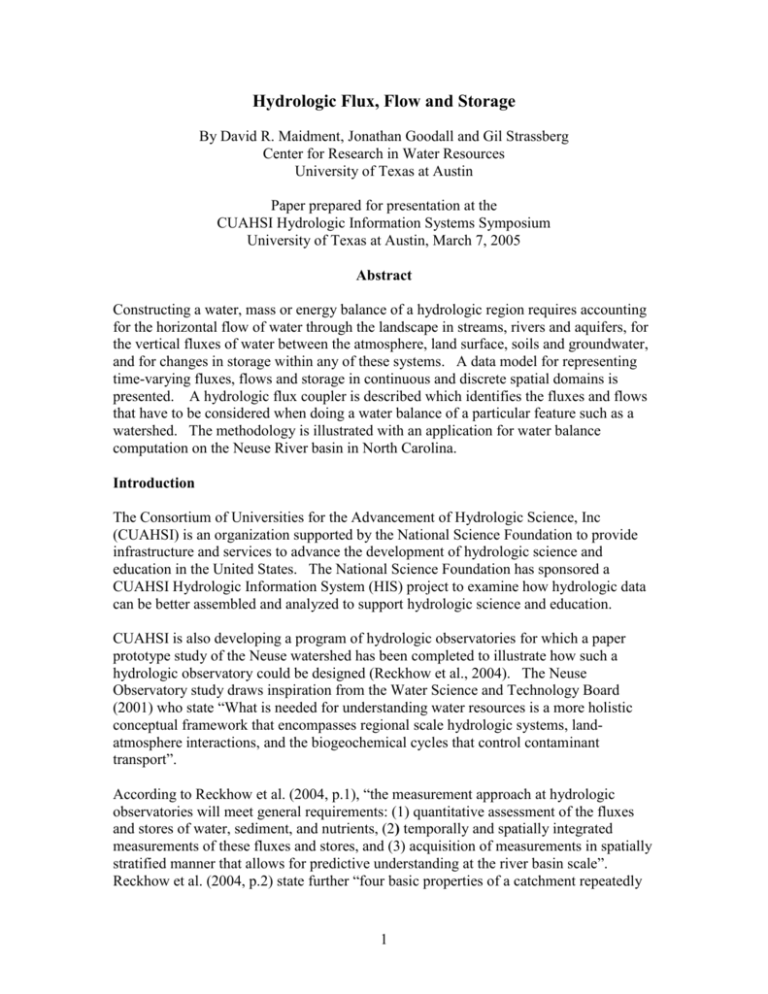
Hydrologic Flux, Flow and Storage
By David R. Maidment, Jonathan Goodall and Gil Strassberg
Center for Research in Water Resources
University of Texas at Austin
Paper prepared for presentation at the
CUAHSI Hydrologic Information Systems Symposium
University of Texas at Austin, March 7, 2005
Abstract
Constructing a water, mass or energy balance of a hydrologic region requires accounting
for the horizontal flow of water through the landscape in streams, rivers and aquifers, for
the vertical fluxes of water between the atmosphere, land surface, soils and groundwater,
and for changes in storage within any of these systems. A data model for representing
time-varying fluxes, flows and storage in continuous and discrete spatial domains is
presented. A hydrologic flux coupler is described which identifies the fluxes and flows
that have to be considered when doing a water balance of a particular feature such as a
watershed. The methodology is illustrated with an application for water balance
computation on the Neuse River basin in North Carolina.
Introduction
The Consortium of Universities for the Advancement of Hydrologic Science, Inc
(CUAHSI) is an organization supported by the National Science Foundation to provide
infrastructure and services to advance the development of hydrologic science and
education in the United States. The National Science Foundation has sponsored a
CUAHSI Hydrologic Information System (HIS) project to examine how hydrologic data
can be better assembled and analyzed to support hydrologic science and education.
CUAHSI is also developing a program of hydrologic observatories for which a paper
prototype study of the Neuse watershed has been completed to illustrate how such a
hydrologic observatory could be designed (Reckhow et al., 2004). The Neuse
Observatory study draws inspiration from the Water Science and Technology Board
(2001) who state “What is needed for understanding water resources is a more holistic
conceptual framework that encompasses regional scale hydrologic systems, landatmosphere interactions, and the biogeochemical cycles that control contaminant
transport”.
According to Reckhow et al. (2004, p.1), “the measurement approach at hydrologic
observatories will meet general requirements: (1) quantitative assessment of the fluxes
and stores of water, sediment, and nutrients, (2) temporally and spatially integrated
measurements of these fluxes and stores, and (3) acquisition of measurements in spatially
stratified manner that allows for predictive understanding at the river basin scale”.
Reckhow et al. (2004, p.2) state further “four basic properties of a catchment repeatedly
1
emerged as important. These properties are: (1) mass in each “store”, (2) residence time
within stores, (3) fluxes between stores, and (4) flowpaths among stores.”
Since the CUAHSI Hydrologic Information System provides the information framework
for hydrologic observatory data it is important to the success of the overall CUAHSI
mission that that this framework should be supportive of the general considerations just
stated concerning hydrologic observatory design. This paper takes the general
requirements for hydrologic observatory design as a point of departure and proposes a
space-time model for hydrologic fluxes, flows and storage on watersheds. An example
application is presented for a monthly water balance for 2001 integrating atmospheric
water, surface water and groundwater in the Neuse basin.
Hydrovolumes
Suppose we take the whole of the Neuse basin, as shown in Figure 1, and extrude the
watershed boundary vertically upward into the atmosphere sufficient to encompass all
atmospheric phenomena likely to be of interest on the basin, and similarly extrude the
watershed boundary downwards into the geological strata sufficient to encompass all
hydrogeologic phenomena affecting the hydrology of the basin. If the resulting vertical
surfaces are enclosed by horizontal planes at the top and bottom, a volume in space
representing the Neuse basin has been isolated from its surroundings, and can thus be
subjected to analysis. In fluid mechanics, this is called a control volume. For the present
purposes, it is termed a hydrovolume, defined as “a volume in space through which water,
energy and mass flow, are stored internally, and transformed”.
Figure 1. A hydrovolume of the Neuse basin
2
The exercise just performed could similarly be carried out at the watershed scale for any
watershed within the Neuse basin. For purposes of illustration, the basin has been
divided into 20 watersheds, by using selected USGS streamgaging station as outlet
points, as shown in Figure 2. This arrangement is arbitrary and uses only a portion of the
USGS gaging stations in the basin, sufficient to create a subdivision of the basin into
reasonable number of watersheds of similar size.
Figure 2. The Neuse basin divided into watersheds.
In particular, two watersheds are highlighted in Figure 2: (1) the watershed draining to
the USGS gage 02092500 on the Trent River near Trenton NC; and (2), the watershed
draining to the USGS gage 02092554 downstream on the Trent River at Pollocksville
NC, as shown in Figure 3.
Figure 3. Two watersheds draining to USGS gaging stations in the Neuse basin
3
Watershed 1 has only one stream outlet and no stream inlets, while watershed 2 has one
stream inlet and one outlet. Inspection of Figure 2 shows that there are other watersheds
with as many as three stream inlets and one outlet. Suffice it to say, that if a set of stream
gages is selected, the resulting drainage analysis subdivides the basin into a set of discrete
watersheds, where all streamflow passing through the boundary between one watershed
and another are measured at a gaging station.
If Hydrovolumes are drawn around these watersheds, the result is shown in Figure 4.
Within a hydrovolume, one can define a geovolume as “the portion of a hydrovolume
containing solid earth materials”.
Figure 4. Geovolumes and hydrovolumes in the Neuse basin.
The process of spatial subdivision of the Neuse basin hydrovolume can be applied
repeatedly to create smaller and smaller watershed hydrovolumes; each of these can be
layered vertically to produce hydrovolumes representing atmospheric layers, soil layers,
and hydrogeologic units; channel hydrovolumes representing stream and river reaches
can be created as separate hydrovolumes within a watershed hydrovolume; estuary
hydrovolumes can be differentiated from the streams draining into them, and so on. Any
spatial subdivision of a hydrovolume is a hydrovolume.
Figure 5 shows a three-dimensional channel hydrovolume created for part of the Trent
River using the River Channel Morphology Model developed by Merwade (2004), which
mathematically relates the size and shape of the river channel cross-section to its
planform sinuosity and hydraulic geometry parameters. The three-dimensional character
of the channel is represented geospatially by a wire mesh of Crossections transverse to
4
the flow and ProfileLines in the direction of flow. Hydraulic modeling can be used to
estimate the flow velocity and depth throughout the length of this channel reach for a
range of discharge values. A small hydrovolume for one channel segment is also shown
in Figure 5.
Figure 5. Three-dimensional channel hydrovolumes created for the Trent River.
The CUAHSI Hydrologic Information System is creating the tools needed to define
hydrovolumes, and geovolumes as three dimensional geospatial features in a watershed
system.
Flux, Flow and Storage
The CUAHSI conceptual model of a hydrologic observatory calls for “quantitative
assessment of the fluxes and stores of water, sediment, and nutrients”. This calls for
some formal definition of the terms flux and store. In hydrology, the volumetric flow
rate of water is usually symbolized by Q, measured for streams in cubic feet per second.
If a surface is of area A, and the flow of water passing through that surface is Q, then the
flux is the “flow per unit of surface area”, or q = Q/A. For groundwater flow, the Darcy
flux, q, is the conventional way of describing groundwater flow as the discharge rate per
unit of cross-sectional area of porous medium.
If mass is considered instead of water volume, the mass flow rate is the amount of mass
passing through a surface in a given interval of time, and the mass flux is the mass flow
rate divided by the surface area. For example, the National Atmospheric Deposition
5
Program quantifies the rate of deposition onto the land surface of chemicals in rainfall in
units of kg/ha-year.
When considering land surface – atmospheric interactions, the fluxes of water and energy
are intimately linked, so an energy flux can be defined as the rate at which energy passes
through a surface, usually measured in Watts/m2, where 1 Watt = 1 Joule/sec. For
example, the average net radiation absorbed by the earth’s surface over the globe and
over the year is 105 W/m2.
Strictly speaking, what has so far been defined as a flux is really an area flux since it is
defined by flow per unit area. There are also line fluxes defined by flow per unit length,
such as a channel loss rate in cfs/mile of stream channel. Line fluxes will not be
considered further in this paper.
A store is a location where a quantity can be accumulated. For example, fish
bioaccumlate mercury in their muscular tissues, so fish tissue can be referred to as a store
for mercury. Within a water body, mercury can also be dissolved in the water column,
can attach to colloidal particles in the water, can be contained in aquatic plants, and can
be adsorbed onto bed sediments. Each of these is a store for mercury, so a hydrovolume
containing a water body and its bed sediments could have many stores defined within it.
Suppose we define the term storage of a quantity (i.e. water, mass or energy) within a
hydrovolume as the “total amount of that quantity contained in all stores within a
hydrovolume”. There is thus a fundamental distinction in terms of unit dimensions
among flux, flow and storage, as shown in Table 1.
Flow
Flux
Storage
Water
[L3/T]
[L/T]
[L3]
Mass
[M/T]
[M/L2T]
[M]
Energy
[E/T]
[E/L2T]
[E]
Table 1. Dimensions of flux, flow and storage for water, mass and energy.
Space and Time
The CUAHSI conceptual model of a hydrologic observatory also calls for “temporally
and spatially integrated measurements of these fluxes and stores”. This implies the
existence of a space-time reference frame in three dimensions that is capable of
describing fluxes and flows in a continuous spatial domain such as the atmosphere, or in
a discrete spatial domain such as a river basin with its associated streams, rivers, water
bodies, watersheds, soil and hydrogeologic units, and gaging stations.
Continuous Space-Time Domain
A continuous space-time domain has the characteristics:
6
It is spatially extensive with properties that change smoothly throughout the
spatial domain;
It may vary in one-, two-, or three- space dimensions;
Its properties change smoothly through time and they are defined at regular
intervals within the time horizon.
For example, the North American Regional Reanalysis (NARR) of climate has produced
a space-time grid of weather and climate variables on a 32km grid in space over North
America and 3 hour time intervals from 1979 to 2003. These data were calculated at the
National Centers for Environmental Prediction by rerunning their Eta weather forecasting
model in 3 hour time steps using as input the entire weather observation record from
1979 to 2003 http://wwwt.emc.ncep.noaa.gov/mmb/rreanl/.
Figure 6. Surface evaporation over North America from the North American Regional
Reanalysis of climate visualized with Unidata’s Integrated Data Viewer.
Figure 6 shows a map surface evaporation from the NARR for one 3-hour time interval
visualized with Unidata’s Integrated Data Viewer tool. The NARR also contains daily
and monthly summaries of its variables, which include and land surface properties such
as soil moisture levels, runoff, and subsurface recharge. Weather and climate
information can be visualized using tools from Unidata, a data center supported by the
NSF Geosciences Directorate (in much the same way as is CUAHSI), whose mission is
to supply real-time atmospheric science information to academic institutions. This is a
two-dimensional, time varying space-time field.
The Land Surface – Atmosphere model used in the Eta numerical weather prediction
model is called NOAH, as shown in Figure 7. NOAH calculates for each grid cell and
time step the values of dozens of flux and state variables, including precipitation,
evaporation, potential evaporation, soil moisture level for several soil layers, surface
runoff, and subsurface recharge to groundwater. These data are used in this paper as a
7
representative climate model, but the same fluxes could be generated from a mesoscale
climate model fitted just to a hydrologic observatory region, whose atmospheric
boundary conditions are set by reference to the NARR data, just as the NARR is itself
operating within a global numerical weather prediction model.
Figure 7. The NOAH land – atmosphere model used in the North American Regional
Reanalysis of climate.
Discrete Space-Time Domain
A discrete space-time domain has the characteristics:
It may be represented in space by point, line, area or volume features;
Its properties may be recorded regularly or intermittently in time;
The domain has a boundary that represents the maximum extent in space and time
of its representation.
8
Figure 8. Hydrologic observation data presented on a discrete-space time domain for the
Neuse basin.
For example, time series of hydrologic observations for the Neuse basin in North
Carolina exist within the Neuse basin boundaries, each time series is linked to points in
space where the observations were made, and the time range of the observations within
the current Neuse Hydrologic Observations Database is from 1892 to 2004. Figure 8
shows an ArcIMS viewer developed for the CUAHSI Hydrologic Information System
that permits downloading of data on streamflow, water quality, precipitation,
temperature, and groundwater levels. The streamflow, precipitation and air temperature
data are available regularly in time, while the water quality and groundwater level data
are recorded at irregular points in time.
Data cube
Regardless of whether a hydrologic region is represented on a continuous or discrete
space-time domain, data describing that region can be depicted using a data cube, whose
axes represent the triplet {space, time, variables}. A particular observed data value, D,
is located as a function of where it was observed, L, its time of observation, T, and what
kind of variable it is, V, thus forming D(L, T, V), as shown in Figure 9.
9
Figure 9. The data cube. A measured value D is indexed by its spatial location, L, its
time of measurement, T, and what kind of variable it is, V.
NetCDF as a Continuous Space-Time Data Model
NetCDF is a data model developed at Unidata for the purpose of distributing atmospheric
science data to academic institutions in the United States. The concept of netCDF is that
it represents sampled values of an n-dimensional function space. Suppose we have a set
of variables {X, Y} where the set {X} are independent variables whose values define
coordinate dimensions, or points where information is represented, and the set {Y} are
variable dimensions whose values are defined at those coordinate points. Typical
examples of the set {X} are latitude, longitude, elevation, and time; typical examples of
the set {Y} are temperature, humidity, wind speed, and water vapor pressure. In some
cases where netCDF is used to represent atmospheric model information, the elevation
dimension is replaced by pressure level, indicating the pressure level in the atmosphere of
an atmospheric box whose conditions are being summarized.
When represented on the data cube, the coordinate dimensions {X} cover the space-time
or L-T plane, and the variable dimensions {Y} are the variables on the V axis
perpendicular to the L-T plane, as shown in Figure 10. A particular data value, D, might
represent the relative humidity variable observed or calculated at a particular latitude,
longitude, elevation and time.
10
Figure 10. Representation of the data cube in netCDF.
Unidata has been in operation since 1983, and its netCDF format has proven to be widely
popular in the atmospheric and ocean sciences for representing continuous fluid
properties. It is also used by hydrodynamic modelers who want to record the results of
their calculations on finite element or finite difference grids. NetCDF can also be used to
track fluid properties along a flow path, such as when a balloon is released from the land
surface and rises through the atmosphere to record atmospheric properties.
The merit of netCDF as a hydrology data model is that it can represent fluid fluxes and
properties in continuous space-time domains, and it is a public domain format for which a
significant body of application tools already exists. If CUAHSI were to support and use
netCDF, it would supply a common data format for integration of hydrology with
atmospheric and ocean sciences. The shortcomings of netCDF for hydrologic usage are
that it does not describe discrete spatial domains such as watersheds, stream segments; it
is not intended for describing a collection of time series on various time scales, such as
those recorded by monitoring devices; and it is in a binary format that must be accessed
through an application programming interface. There is an XML (eXtended Markup
Language) version of netCDF which expresses netCDF data as text files in XML format
that may be useful as a data exchange format for transforming netCDF files to other
formats.
Arc Hydro Time Series as a Discrete Space-Time Data Model
Arc Hydro is a customization of the ArcGIS geographic information system for
application in water resources, developed by a consortium of GIS developer and users
(Maidment, 2002). ArcGIS is a built on a geodatabase, which is a relational database
adapted for storing geographic objects.
In Arc Hydro, all points, lines, areas and volumes are hydrofeatures, that are described
by a HydroID and a HydroCode. The HydroID is a unique long integer identifier
assigned by Arc Hydro tools that is used for internal labeling and for building
11
relationships between data tables in the geodatabase. The HydroCode is a text field that
contains the permanent public identifier of a hydrofeature, if one exists. For example,
Figure 3 shows three feature classes for the Neuse basin (Watersheds as areas, Streams as
lines, and Gages as points) overlaid on a digital elevation model of the land surface
terrain, which is an ArcGIS raster. The HydroCode for the gages is their USGS site
number (e.g. 02092500), which identifies observational data stored within the National
Water Information System at those gages. The Watersheds in Figure 3 have a numerical
label 1 or 2, which has a completely different form than a USGS site number. The use of
HydroID as a unique labeling system for all hydrofeatures avoids the confusion that
results if each feature class is labeled in its own way.
In Arc Hydro, any hydrofeature can be related to any number of time series. The Arc
Hydro time series data model as applied to hydrologic observations at monitoring points
(as in Figure 8) is explained in some detail in a companion paper (Maidment, 2005) and
that explanation will not be repeated here. The point relevant to the present discussion is
that by using the Arc Hydro method, any point, line, area or volume feature can be
related to any number of time series describing hydrologic fluxes, flows and storages that
are associated with that feature. In Arc Hydro, the data value is called a TSValue, and
the three axes of the data cube indexing that value are named FeatureID for space,
TSTypeID for the variable type and TSDateTime for the time index, as shown in Figure
11. The FeatureID of the time series is equal to the HydroID of the feature it describes.
Figure 11. Representation of the data cube in Arc Hydro.
Because Arc Hydro time series are linked to the spatial feature they describe, they have
associated with them a shape, which is the set of geographic coordinates defining how
and where they are represented in space. Likewise, they have a type, which refers both
to the nature of the variable they represent and also to the character of its representation
through time. Thus, these can be thought of as geospatial time series, as illustrated in
Figure 12.
12
Figure 12. Geospatial time series
Although Arc Hydro time series were developed within the context of a commercial
system, ArcGIS, it turns out that the time series part of Arc Hydro can be extracted from
the GIS and implemented independently, as a delimited ascii .csv file, and in Excel. The
CUAHSI HIS team has also shown that this time series model can be implemented in
PostgreSQL, which is an open source, public domain relational database.
Linking Continuous and Discrete Space-Time Information
The continuous and discrete space-time data models just described live in quite different
universes. NetCDF is a binary file format that was developed for operation on Linux
and Unix operating systems. Arc Hydro time series are represented as tables in a
relational database, and are normally used in the Access relational database which is part
of Microsoft Office under the Windows operating system. How can data from these two
systems be connected and merged?
ArcGIS allows for the inclusion of two-dimensional rasters or grids. An ArcGIS grid
has square cells of a single fixed size, is defined on a rectangular domain, and describes a
single variable in its cell values. A set of rasters can be stored in a raster catalog, and
indexed by their date and time if they represent time varying information, to form a raster
series. Rasters can be laid over spatial features such as watersheds and the average value
of the raster within the boundary of each feature calculated. Two-dimensional fields in
netCDF format, like the surface evaporation fields from the NARR shown in Figure 5,
can be converted to geospatial time series linked to points located at the center of each
NARR cell. Within ArcGIS, these geospatial time series can be spatially interpolated
into a raster series, laid over the watersheds and the corresponding geospatial time series
of watershed properties can be determined. This is how energy and water fluxes from
the NARR were acquired for the water balance on the Neuse basin described later in this
paper. NetCDF is presently being incorporated into ArcGIS as a native data format, and
tools to read, write, display and operate on netCDF files will exist in the next release of
ArcGIS due out at the end of 2005 or early in 2006.
13
Computing a Water Balance
The drainage area of a river basin can be divided into watershed hydrovolumes by
delineating the watershed that flows to each streamgage in the basin, as shown in Figures
2 and 3. Upstream watersheds are bounded entirely by drainage divides and have only
the gage at their outlet by which they communicate with adjacent modeling units.
Downstream watersheds may have two or more gages on their boundary transmitting
flow into and out of the modeling unit, as shown in Figure 3. For any one of these units,
a simple water balance can be written as:
dS
Qin Qout ( P E R) A
dt
(1)
Where S is the storage of water in the watershed, Qin is the flow coming into the unit as
measured by gages on its upstream boundary, Qout is the outflow at the gage at the
downstream end, P is precipitation, E is evaporation, R is groundwater recharge, and A is
the area of the watershed. This water balance links vertical fluxes of water between the
atmosphere, land surface and subsurface with horizontal flows of water through the
stream channel system.
Equation (1) is a straightforward equation but its automated application within a
Hydrologic Information System is not simple. First, it requires knowledge of the spatial
distribution of precipitation and evaporation over the drainage area in order to be able to
get the appropriate values for the watershed as a whole; second, the dimensions of the
inflow and outflow data, usually cfs, are inconsistent with typical units for P, E and Rof
in/day or mm/day, respectively; third, the drainage area is needed, and that involves yet
another set of units, say km2 or miles2. Qin and Qout are flows associated with stream
gages represented as point hydrologic features in the landscape, while P, E and R are
fluxes associated with the watershed as an areal hydrologic feature, so the multiplication
by the watershed area is necessary to make the computations dimensionally consistent.
The rate of storage change, dS/dt, and its integral through time, cumulative storage, S, are
time series associated with the watershed as an areal hydrologic feature. In general, all of
these hydrologic fluxes, flows and storages can be represented as geospatial time series,
that is time series which have associated with them some point, line, area or volume
feature, as shown in Figure 10.
Equation (1) can be partitioned by considering the term (Qin – Qout) as the net inflow of
water to the watershed hydrovolume through the channel system. Similarly (P – E – R)
is the net influx of water from the atmosphere to the land surface, and if this flux is
multiplied by the watershed area, A, and the appropriate unit conversions done, the result
(P – E – R)A, is the net inflow of water from the atmosphere to the land surface. Thus,
Equation (1) can be rewritten as
dS
(NetInflows)
dt
(2)
14
Now, suppose this water balance does not close because of data uncertainties and errors,
the degree of non-closure of the water balance can be estimated by a residual flow, Qr,
defined as
Qr
dS
(NetInflows)
dt
(3)
Of course, this requires some means of independently estimating dS/dt, such as by
converting changes in water surface elevation in a reservoir to changes in storage, or by
mapping piezometric head fields in a groundwater system through time and looking at
their time variation.
The computation of heat energy balances can be done in a similar fashion to that just
described for a water balance with the additional degree of complication that energy
comes in many forms (short wave and long wave radiation, sensible heat flux, latent heat
flux, ground heat flux). The computation of mass balance for chemical and biological
constituents of water is significantly more complex again because these constituents can
exist in many stores, and they can also be created or destroyed within a hydrovolume.
However, the basic principles are still the same.
Reckhow et al. (2004, p.42) describe a model for mass balance of Radon in the Neuse
estuary which includes: “(1) benthic advective-diffusive exchange; (2) in situ production
and loss; (3) horizontal water column advection; (4) air sea – exchange”, whose result is
the time variation of Radon concentration in the estuary. If this is multiplied by the
volume of water in the estuary it gives the time variation of the mass of Radon stored
there. They state “this approach assesses all flux terms and estimates the groundwater
contribution by difference”, in other words, the unknown residual flow of radon in
groundwater to the Neuse estuary is estimated as a term Qr in Equation (3) where the Net
Inflow terms have also to include the difference between radon production and loss
within the estuary waters.
Although the water balancing methodology described here does not address these
additional layers of complexity to be confronted in mass balancing of chemical or
biological constituents, it does establish a space-time context for constructing such mass
balances that might be elaborated by additional developments later.
Hydrologic Flux Coupler
The hydrologic flux coupler is an application developed in ArcGIS to allow water, energy
or mass balances to be constructed for hydrovolumes defined in atmospheric, surface and
subsurface water. Each hydrovolume is treated as a separate discrete space entity with
its own fluxes and flows, linked to the hydrovolume using a coupling table. It should be
understood that it is not the purpose of the flux coupler to define the magnitudes of all the
fluxes and flows, but rather to take estimates for fluxes and flows developed by
measurements and modeling, and bring these together to compute a water, energy or
mass balance in a hydrologic landscape divided into hydrovolumes.
15
Example Application to the Neuse basin
An example application of the hydrologic flux coupler to the Neuse Basin is now
presented. For purposes of explanation, this example is confined to the two watershed
hydrovolumes depicted in Figure 4. The purpose is to compute a monthly surface water
balance for the year 2001 using as inputs USGS streamflow data at the gages, and vertical
fluxes for precipitation, evaporation and groundwater recharge obtained from the North
American Regional Reanalysis of climate (NARR). The example is carried out in a
series of steps.
Step 1: Establish and label the hydrovolumes
A terrain analysis is conducted using a digital elevation model of the land surface, and the
locations of stream gages on the river network. In this case, the Arc Hydro toolset is
used to delineate the watershed draining to each gage, but that task could have been
undertaken with other toolsets also. Two feature classes are used in this example,
watersheds and gages. Each of the watersheds and gages is uniquely labeled with its
HydroID using the Arc Hydro tool Assign HydroID. In this case, the two watersheds
have HydroID’s of 9623 and 9614, respectively, and the gages at their outlets have
HydroID’s of 9748 and 9749. HydroID’s are arbitrary integers that may not have any
inherent meaning – their only purpose is to serve as identifying numbers.
Figure 13. Watershed hydrovolumes and related streamgage features
Step 2. Assemble the flux and flow data
North American Regional Reanalysis (NARR): The NARR contains the full water and
energy balance for North America over a 25 year period (1979-2003). It is computed
using the most current regional weather prediction model (ETA) and assimilated weather
observations from the 25 year period. The grid spacing of the model is 32 km and the
temporal scale is 3hours. The model results are in GRIB binary format at the NARR
website http://www.emc.ncep.noaa.gov/mmb/rreanl/ and were converted to netCDF
format for this example using data converters supplied by Unidata. Some data
manipulation was required to convert the resulting files into monthly data calculated over
each watershed, as discussed earlier in the paper.
16
USGS streamflow measurements: Streamflow measurements were downloaded from the
USGS NWIS website (http://waterdata.usgs.gov/nwis/) – the measurements come as
daily average streamflow in cubic feet per second, and these were averaged for each
month to give mean monthly discharges. The hydrologic flux coupler has tools to
automatically accomplish this time up-scaling.
3. Convert the fluxes and flows to Arc Hydro format
This involves reading the time series in an MS Access database to form time series tables.
In this example, a total of 18 different geospatial time series were created as shown in
Figure 14. Not all of these are needed to do a water balance – in fact, a complete set of
energy fluxes is also in the table so that an energy balance for each watershed could also
be calculated if desired.
Figure 14. Geospatial time series types created for the water balance application.
Step 4. Establish the flux coupling table
The flux coupling table is shown in Figure 15. The FeatureID is the HydroID of the
Hydrovolume being studied, the SourceSinkID is the HydroID of a feature that has time
series on it needed for the computation, the TSTypeID specifies the type of time series,
and the Direction specifies whether IN (Direction = 1) or OUT (Direction = 2).
Watershed hydrovolume 9623 has three vertical fluxes in kg/m2-day associated with it:
Types 14 (Precipitation), 15 (Subsurface discharge), 16 (Evaporation) – these are areally
17
associated with the watershed itself (i.e. the SourceSinkID and the FeatureID are the
same) to get the watershed area in order to convert these fluxes to flows. This
hydrovolume also has one flow of Type 5 (Monthly streamflow in cfs) associated with it,
whose SourceSinkID is 9748 which means that the flow series are attached to the stream
gage at the watershed outlet.
A similar set of coupling records exists for the downstream watershed hydrovolume 9614
– except that it has two streamgage flows at SourceSinkID’s of 9748 and 9749,
respectively. Notice how the Direction for gage 9748 is 2 (OUT) when it is associated
with hydrovolume 9623 and 1 (IN) when it is associated with hydrovolume 9614. The
same flow can is used as an outflow for one hydrovolume and an inflow to the next.
Figure 15. The hydrologic flux coupling table and its related features
5. Plot the fluxes and flows
The hydrologic flux coupler creates plots in Arc Map of geospatial time series. Figure 16
shows two plots, the one on the left being the average monthly streamflow in cfs, and the
one on the right the various flux components. Graphs can be “dragged” from one chart
space to the other and their units and dimensions will automatically be converted to be
conformal with the target chart space. The flux and flow data can be exported to another
application by right clicking on the graph and selecting the desired option, such as .txt, or
Excel.
18
Figure 16. Flows and fluxes for hydrovolume 9623
6. Calculate the Net Inflow and Net Influx
For each hydrovolume, the net inflow is calculated as the difference between the
streamflow into and out of the hydrovolume (Qin – Qout) in cfs, and the net influx is
computed as P – E – R, shown in Figure 17 now in units of in/hr (any one of a number of
possible alternative units could have been chosen and the conversion to that unit system
is made automatically).
19
Figure 17. The net inflow and net influx of water to hydrovolume 9623.
7. Calculate the total net inflow and integrate storage through time
The total net inflow is calculated as (Qin – Qout) + (P – E – R)A where A is the watershed
area – this yields a continuous change in storage in cfs, according to Equation (2) and this
can be integrated through time to plot a profile of the storage of water on the watershed
as shown in Figure 18. It is apparent that the water balance does not close as the storage
shows a persistent downward trend through the year, 2001.
20
Figure 18. The total net inflow and its accumulation of storage through time for
hydrovolume 9623.
8. Improve the water balance
The fluxes used in this example are all drawn from the NARR. Suppose one wished to
improve the water balance with better data. Some options are:
Precipitation – Use gage-adjusted Nexrad radar precipitation instead of NARR modeled
precipitation. The Neuse digital watershed presently contains one year of daily Nexrad
data for 2004 and a more extensive historical archive of Nexrad data will be created.
These data are acquired from the NWS West Gulf River Forecast Center.
Evaporation – Use evaporation data from atmospheric flux towers in or near the Neuse
basin to adjust the evaporation fields from the NARR to more realistically estimate
evaporation fields over the basin.
Subsurface Recharge – estimate from change in piezometric head elevation in the
surficial aquifer. Figure 19 shows groundwater level measurements obtained form the
North Carolina Division of Water Resources groundwater database
(http://www.ncwater.org/Data_and_Modeling/Ground_Water_Databases/)
The measurements are in feet below the land surface at the well location, and have
irregular time intervals between measurements. These data can be assembled and
interpolated for each month, and the change in groundwater storage in the surficial
21
aquifer estimated from the change in piezometric head elevation and knowledge of the
aquifer properties. The USGS is presently constructing a Modflow model for this
aquifer and when completed, that model could be used to improve the surface water
balance through better estimates of the recharge and discharge between surface, soil and
groundwater.
Water level measurements
Interpolated water surface
Figure 19. Average Water level measurements for February 2001 and water surface
interpolated for that date
Conclusions
The methodology described in this paper shows how water balances involving hydrologic
fluxes, flows and storage can be computed for watersheds within the Neuse river basin.
The same methodology can be used for energy balances on the watershed surface, and
with some extension, could also be applied to mass balancing of chemical and biological
constituents. These balances are defined on hydrovolumes which are volumes in space
drawn around the watersheds through which water, energy and mass flow, are stored
internally, and transformed.
The methods described here depend on coupling fluxes and flows in both continuous and
discrete space-time, accomplished for the continuous fields by using the netCDF data file
format, and for the discrete space-time fields by using the Arc Hydro geospatial time
series approach. A hydrologic flux coupler links flux, flow and storage and enables
automated computations and unit conversions in constructing the water, mass and energy
balances.
References
Maidment, D.R., (2002), “Arc Hydro: GIS for water resources”, ESRI Press, Redlands
CA.
Maidment, D.R., (2005), “A data model for hydrologic observations”, Paper presented to
the CUAHSI Hydrologic Information Systems Symposium, University of Texas at
Austin, March.
22
Merwade, V. (2004). "Geospatial Desecription of River Channels in Three Dimensions".
PhD dissertation submitted to the Graduate School, University of Texas at Austin.
http://www.crwr.utexas.edu/gis/gishydro04/Modeling/Data/dissertation_merwade.pdf
Reckhow, K., et al., (2004), “Designing hydrologic observatories: a paper prototype of
the Neuse watershed”, CUAHSI Technical Report No. 6, Consortium of Universities for
the Advancement of Hydrologic Science, Inc, 84 pp., December.
Water Science and Technology Board (2001), “Envisioning the agenda for water
resources research in the twenty-first century”, National Research Council, National
Academy Press, Washington DC, 70p.
23

